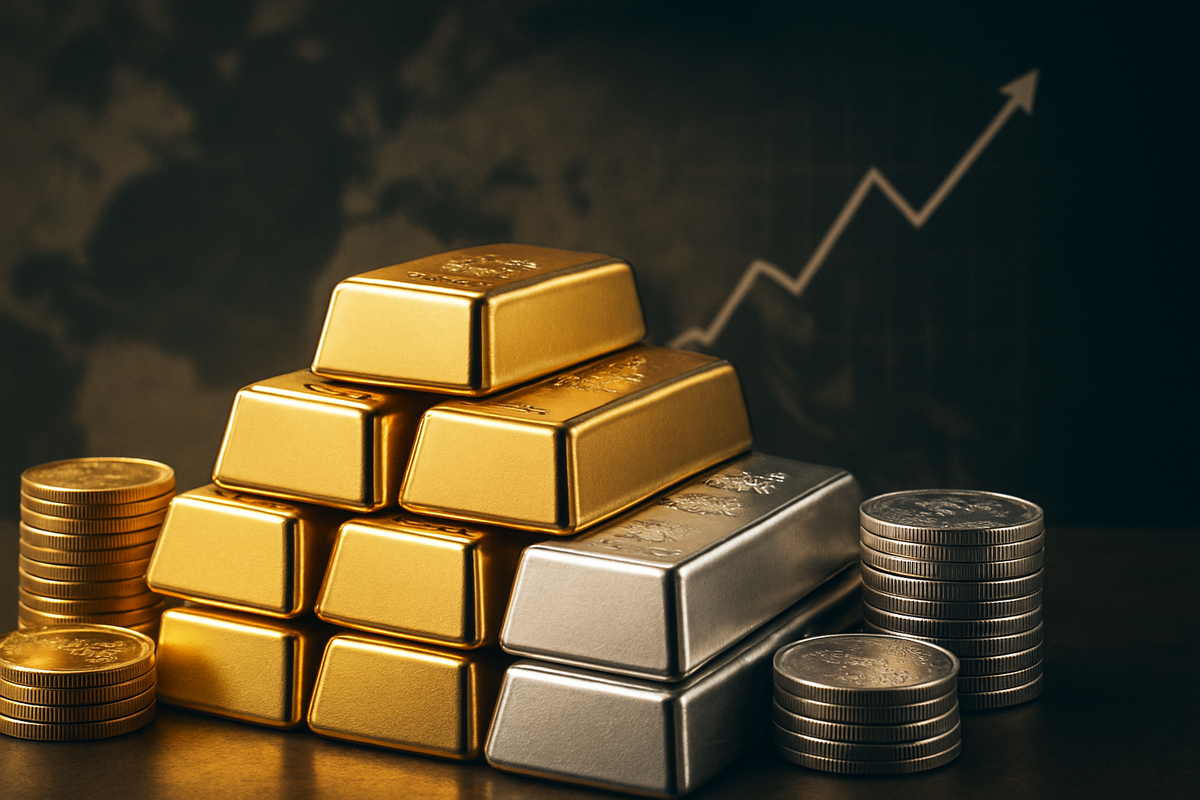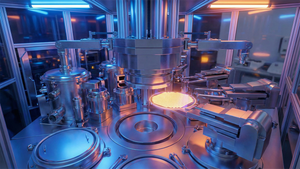Financial News
Precious Metals Soar: Gold and Silver Rally Amidst Rate Cut Speculation and Global Turmoil

As of November 25, 2025, the financial markets are witnessing a dramatic surge in the prices of gold and silver, with both precious metals reaching elevated levels not seen in years. This sharp uptrend is primarily fueled by a potent combination of increasing market expectations for a U.S. Federal Reserve interest rate cut in December, coupled with persistent global geopolitical uncertainties and lingering inflation concerns. The rally signifies a notable shift in investor sentiment towards safe-haven assets, prompting a re-evaluation of portfolios across the board.
The immediate implications of this surge are profound, indicating a robust demand for store-of-value assets in an era marked by economic unpredictability. Analysts are forecasting continued bullish momentum, with some projecting gold to hit unprecedented highs. This scenario underscores a broader narrative of economic fragility and a collective search for stability amidst a complex global landscape.
The Catalysts Behind the Commodity Boom
The current precious metals rally is a culmination of several intertwined factors that have been building throughout 2025. On November 25, spot gold prices jumped by 1.2% to $4,111.86 per ounce, while U.S. gold futures for December delivery settled at $4,094.2 per ounce. Silver mirrored this robust performance, with spot silver gaining 1.7% to $50.84 per ounce, even touching $51.57 USD/t.oz earlier in the day. This represents a significant 10.15% increase for silver over the past month and an astounding 69.59% gain year-over-year.
The most significant immediate catalyst is the burgeoning market conviction that the U.S. Federal Reserve will implement an interest rate cut in December. According to the CME FedWatch tool, bets for such a cut are as high as 79%. Statements from influential Federal Reserve officials, including New York Fed President John Williams and Fed Governor Christopher Waller, have indicated a leaning towards a December reduction, citing concerns over a potentially deteriorating job market rather than persistently high inflation. For non-yielding assets like gold and silver, lower interest rates reduce the opportunity cost of holding them, making them more attractive to investors.
Compounding this monetary policy outlook are ongoing global uncertainties and geopolitical tensions. The persistent conflict in Ukraine, with Russia launching new attacks on Kyiv on November 25, 2025, along with lingering instability in the Middle East, continues to drive demand for safe-haven assets. These geopolitical "swings" create an environment of heightened risk aversion, prompting investors to seek refuge in tangible assets. Furthermore, while some inflation data might suggest moderation, underlying inflationary pressures, as evidenced by an all-time high national median home sales price for October, maintain precious metals' appeal as a hedge against the erosion of purchasing power. Initial market reactions have been overwhelmingly positive for precious metals, with analysts expressing a moderately bullish outlook for silver and a short-term bullish bias for gold, with some, like Bank of America (NYSE: BAC), forecasting gold to average $4,538 per ounce in 2026 and potentially reach $5,000.
Companies Poised to Win and Lose
The surge in gold and silver prices presents a clear delineation between potential winners and losers in the public markets. Mining companies are undoubtedly positioned to be major beneficiaries. Companies like Barrick Gold Corporation (NYSE: GOLD), Newmont Corporation (NYSE: NEM), and Fresnillo PLC (LSE: FRES) are likely to see significant boosts to their revenues and profitability as the value of their primary products increases. Higher commodity prices directly translate to fatter margins, especially for miners with lower production costs. Exploration companies in the precious metals sector could also attract increased investment, leading to a resurgence in exploration activity.
Conversely, companies heavily reliant on silver as an industrial commodity might face increased input costs, potentially squeezing their profit margins. Industries such as solar panel manufacturing, electronics, and electric vehicle (EV) production utilize significant amounts of silver. While the long-term demand from these green technologies is a bullish factor for silver, in the short to medium term, a sharp price increase could pose challenges for companies like First Solar, Inc. (NASDAQ: FSLR) or various automotive suppliers if they cannot effectively pass on these higher costs to consumers. Additionally, certain industrial manufacturers that use gold in specialized applications, such as dentistry or high-end electronics, might also experience increased operational expenses.
Furthermore, investors holding Exchange Traded Funds (ETFs) that track gold and silver prices, such as SPDR Gold Shares (NYSEARCA: GLD) and iShares Silver Trust (NYSEARCA: SLV), will see their portfolios appreciate. Conversely, companies whose business models are negatively impacted by economic uncertainty and a flight to safety might experience downward pressure on their stock prices as investors reallocate capital towards precious metals and other defensive assets.
A Wider Lens: Broader Trends and Historical Context
The current rally in gold and silver is not an isolated event but rather fits into several broader industry trends and economic shifts. It underscores a growing global distrust in fiat currencies and a return to tangible assets as a hedge against systemic risks. This trend is amplified by unprecedented levels of global debt and persistent fiscal deficits across major economies, which often lead investors to question the long-term stability of traditional financial instruments. The continuous accumulation of gold by central banks worldwide, alongside the notable move by Russia, India, and Saudi Arabia to incorporate silver into their reserve strategies, signals a fundamental structural shift. This institutional demand suggests a "return of silver as a monetary metal" and provides a robust floor for prices, indicating a long-term re-evaluation of its role in the global financial system.
Historically, precious metals have served as reliable safe havens during periods of economic uncertainty, geopolitical turmoil, and inflationary pressures. The 1970s, characterized by high inflation and geopolitical instability, saw significant surges in gold prices. More recently, the aftermath of the 2008 financial crisis and the initial phases of the COVID-19 pandemic also triggered substantial rallies, demonstrating their counter-cyclical nature. This current surge aligns perfectly with these historical precedents, reinforcing the metals' traditional role as a crisis commodity. Regulatory or policy implications could arise if the price volatility becomes extreme, potentially leading to increased scrutiny of futures markets or calls for greater transparency in precious metals trading. However, for now, the focus remains on the macroeconomic drivers.
The increasing industrial demand for silver, particularly from burgeoning green technologies like solar panels and electric vehicles, adds another layer to its long-term growth potential. This dual role as both a precious metal and an industrial commodity contributes to its consistently higher volatility but also underpins a structural supply deficit, supporting higher prices in the long run. Many analysts believe this is not merely a temporary rally but a "structural shift" in the precious metals market, driven by a confluence of monetary constraints, industrial demand growth, and geopolitical realities, suggesting sustained appreciation over multiple years.
Navigating What Comes Next
Looking ahead, the trajectory of gold and silver prices will largely depend on the actualization of the anticipated Federal Reserve rate cuts and the evolving global geopolitical landscape. In the short term, if the Fed indeed cuts rates in December, precious metals are likely to experience further upward momentum. However, any hawkish signals or a delay in rate cuts could introduce volatility and potential pullbacks. Market opportunities may emerge for investors to buy on dips, particularly if the broader macro environment remains supportive of safe-haven assets.
In the long term, the outlook remains bullish. The structural shifts, including sustained central bank demand, ongoing inflationary pressures, and the increasing industrial application of silver, suggest that precious metals will continue to play a crucial role in diversified portfolios. Potential strategic pivots for mining companies might include accelerating exploration and development projects, while industrial users of silver may need to explore hedging strategies or alternative materials to mitigate cost increases. Emerging market economies, often sensitive to commodity price fluctuations, could see varying impacts depending on their net import/export positions for these metals.
Potential scenarios range from a continued steady climb, supported by accommodative monetary policies and persistent global risks, to periods of consolidation or even temporary corrections if economic data improves unexpectedly or geopolitical tensions ease. However, the overarching theme of global indebtedness and a search for tangible value is expected to provide a strong underpinning for gold and silver prices for the foreseeable future.
A Comprehensive Wrap-Up: Enduring Value in Uncertain Times
The sharp increase in gold and silver prices as of November 25, 2025, is a clear signal from the market: investors are bracing for continued economic uncertainty and seeking refuge in time-tested stores of value. The confluence of anticipated Federal Reserve rate cuts, persistent global geopolitical tensions, and underlying inflation concerns has created a potent environment for precious metals to thrive. This rally is not just a fleeting event but rather indicative of a deeper structural shift in the global financial landscape, where central banks and individual investors alike are re-evaluating the role of tangible assets.
Moving forward, the market will closely watch for concrete actions from the Federal Reserve regarding interest rates, as well as any significant developments in geopolitical hotspots. For investors, the key takeaway is the enduring significance of gold and silver as hedges against inflation and economic instability. While short-term volatility is always a possibility, the fundamental drivers supporting a bullish outlook for precious metals appear robust for the coming months and years. Investors should consider a diversified approach, potentially including physical metals, precious metal ETFs, and shares in well-managed mining companies, while always conducting thorough due diligence. The current environment underscores the timeless adage: in times of uncertainty, gold and silver shine brightest.
This content is intended for informational purposes only and is not financial advice
More News
View More




Recent Quotes
View More
Quotes delayed at least 20 minutes.
By accessing this page, you agree to the Privacy Policy and Terms Of Service.



